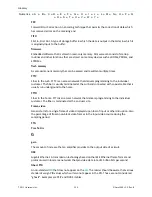
Glossary
© 2013 Harmonic Inc.
368
Ellipse 3000 r.3.0, Rev. B
AAL5
ATM
Adaptation Layer 5. Performs the functions necessary to adapt frame oriented data
information, such as MPEG transport streams and IP datagrams, to the ATM cell format.
AC-3
Also known as Dolby Digital.
ACG
Access Control Group. An identifier that links control words (
CW
s), entitlement control
messages (
ECMs
), and packet identifiers (
PID
s) to a common group.
ACM
A card for the MN20 multiplexer. The ACM supports DES and DVB protocols.
adapter
A circuit board in a Harmonic encoder. Adapters have input or output ports. Also known as a
card or a blade.
AEM
Audio adapter used in MN20 remultiplexer, it can compress two stereo pairs of either analog
or digital audio into the MPEG-1 layer II.
AES3 Standard
The standard for serial transport of digital audio in professional devices, developed by the
Audio Engineering Society (AES) originally in 1992. It has been revised a number of times
since then, with the current revision published in 2010, breaking the original document into
multiple Parts. Some obsolete references term it “AES/EBU,” since the EBU also published the
original document in 1992 as EBU Tech. 3250.
AFD
Active Format Description. Signaling describes certain spatial characteristics of a high
definition or standard definition video image. AFD and Bar Data are intended to be broadcast
with the video signal that they describe. AFD information is intended to assist DTV displays in
optimizing the displayed images. AFD may also be used by intermediate professional video
equipment in conversion of video images of one aspect ratio into an image of another aspect
ratio. Bar Data information is used to signal the precise unused areas of active video when the
active image does not completely fill the picture area, in particular widescreen cinema
material carried letterboxed in a frame with bars top and bottom. AFD is documented by
SMPTE 2016 (multiple part document) and its carriage in compressed video is documented in
DVB/ETSI TS 101 154, ATSC A/53 Part 4, ATSC A/72 Part 1, SCTE 128, and other standards.
AGC
Automatic Gain Control. Keeps the output signal of a circuit constant while the input signal
amplitude varies.
















































